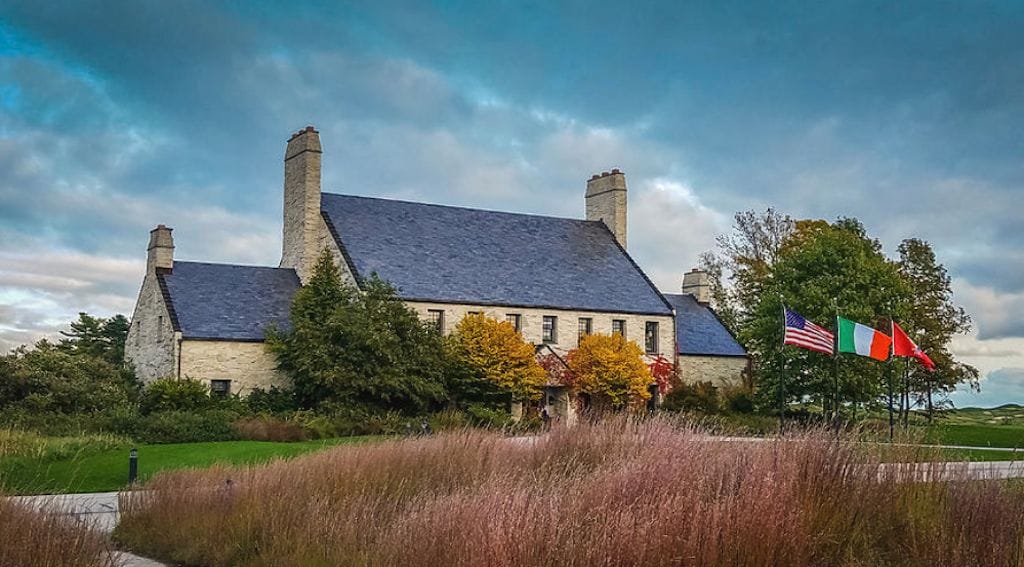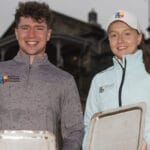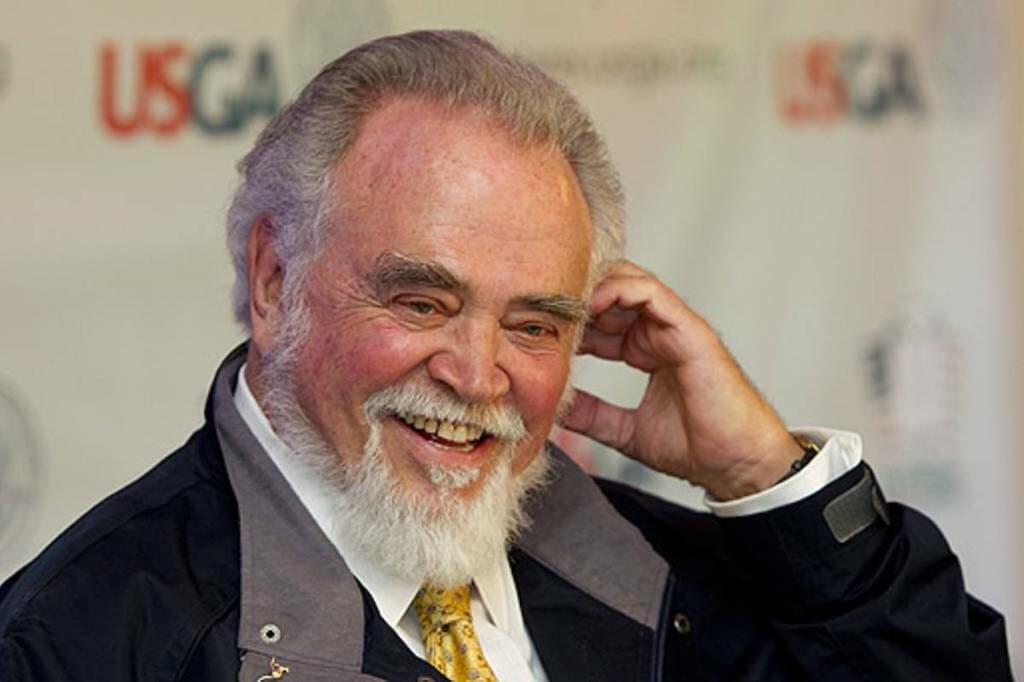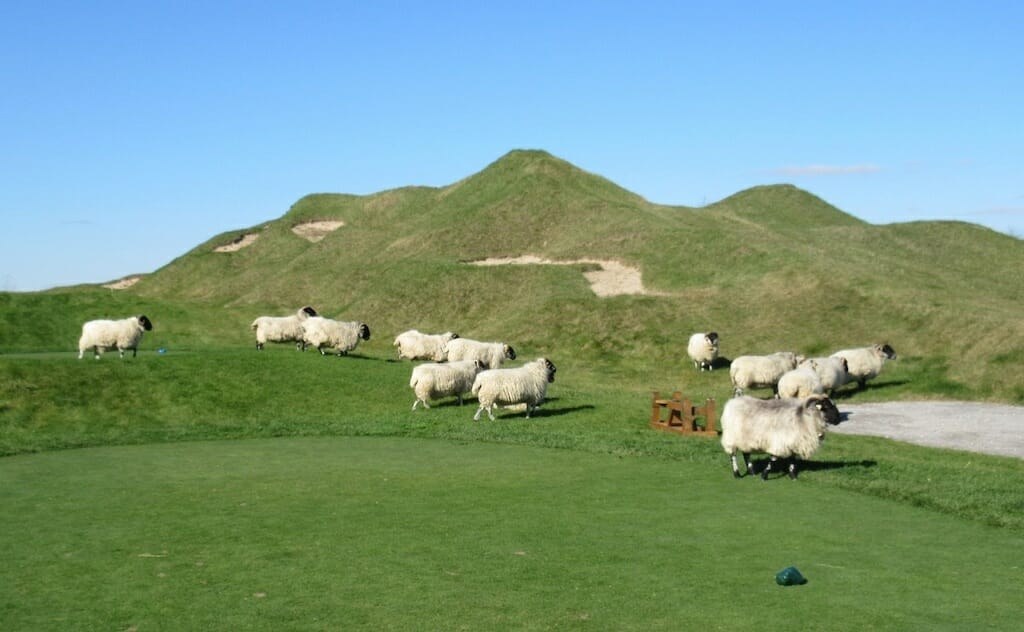If Shane Lowry needed any more Ryder Cup motivation it would be the sight of the Irish flag proudly flying in the centre of a three-flag feature formation at Whistling Straits.
Usually, the sight of the Ireland flag anywhere overseas is among a row of other countries’ flags but not when you arrive at the Wisconsin venue that plays host this week to the Ryder Cup as the Irish flag takes centre stage sandwiched between the Stars and Stripes and the Wisconsin State flag (see photograph) in front of the Whistling Straits clubhouse.
The Ireland flag is in honour of the Irish Course along with the Straits Course, the two golf courses laid-out along the Lake Michigan shoreline. And while Sun City has its man-eating crocodiles, Lake Karrinyup its kangaroos, Lahinch its goats, Whistling Straits also boasts a flock of Scottish black face sheep.
It was billionaire and now retired businessman Herb Kohler’s love of the ancient club-and-ball game, including multi visits to Scotland and Ireland, that led to him naming the Irish Course and also introducing sheep. The flock of around a dozen horned wooly residents are free to run over both courses during the golf season but for the staging of both the 2010 and 2015 PGA Championships and along with this week’s Ryder Cup, the sheep will be moved to an off-site farm.
So, and excuse me for a second, there will be no ‘baaaaad’ shots during the hosting of the 43rd Ryder Cup. It was Kohler’s wish to reproduce on both courses that Ireland and British Isles feeling of playing golf and where the sheep are free to wander about the course though unlike their Scottish cousins at Brora Golf Club, there are no electric fences to stop the sheep wandering onto the greens in this part of rural Wisconsin.
Kohler tells a story of the day he and course designer Pete Dye were out on the Straits course and Dye had with him his trusty German Shepard named ‘Sixty’.
“Sixty was pretty sharp like most shepards and sneaks around behind the sheep and notices one of the sheep had drifted away from the flock,” said Kohler.
“The dog cuts off this sheep and it runs off and into the water, and where it starts paddling. Next minute the sheep starts sinking and Sixty is very happy with himself and starts performing circles (laughing).”
The other side of that story, told by Kohler’s son David, who in 2015 and at the time of the interview was CEO of the company, was that ‘Sixty’ saw the sheep in distress and went out and saved it.
Take a look at the official 2015 PGA Championship poster and you’ll find four Scottish black-face sheep mingling around one of the greens.
When Kohler stood beside Dye in July 1998 at the opening ceremony of the Straits Course, he was still some years away from buying two of the more famed landmarks in St. Andrews. The Kohler Company had been founded in 1873 by one of his relatives, who had emigrated from Austria and began running a Wisconsin dairy farm before purchasing a steel foundry.
From there the company turned to making bathroom and kitchen fittings and needing accommodation for the workers, they began building houses in the then named town of Riverside. In 1900, the town was renamed Kohler.
In 1972, and aged just 33 years, Herb was appointed chairman of the board and CEO and after learning the game playing with his father (Herbert Snr) he decided in 1983 the time was ripe to learn to play golf.
Two years earlier in 1981, the Kohler organisation opened the American Club to provide accommodation and cater for golfers who were travelling to courses not owned by Kohler to play.
“We were taking them to a little private course about 15-minutes away and a public course 25 minutes away,” said Kohler in an interview with the USGA.
“One day a young accountant brought a stack of suggestion slips into my office. He said, ‘I have been collecting these [slips] and this particular stack all has to do with the golf course. These people are saying thank you for enabling golf, but why in the world aren’t you building your own golf course.’ I had never even thought of it.
“Fortunately, I had a vice president of development who was about a 3-handicap. And after a week of conversations, we decided we might as well try and build a course.”
Fast forward to 2004 and the now golf-mad Kohler purchased the Old Course Hotel at St. Andrews and with it came the Peter Thomson designed The Dukes course on the outskirts of St. Andrews.
In 2009 Kohler tripled his business interests in the Auld Grey Toon by purchasing the very run-down Hamilton Hall and turning the former St. Andrews University Hall of Residence into 26 luxury apartments, renaming the building Hamilton Grand.
A year later, just a few weeks after being present for the 2010 Open Championship on the Old Course, Kohler’s American Club complex was the official player hotel for the 2010 PGA Championship won by Martin Kaymer. Three years later in 2013 and Kohler was afforded membership of the R&A which had been repeatedly denied to Thomas Hamilton following the opening in 1885 to the building named after him.
Now aged 82 and estimated to be worth $9.8b, Kohler still manages to play the odd game of golf. Soon after retiring in 2015, he took great pride in winning the Gnarly Balls title for an eighth time, a contest between other Kohler Company employees and local residents.
The Gnarly Balls isn’t about scores, it’s about the money you win from betting. And the prize is a pair of rusted casting balls from a Kohler foundry connected by a rusting chain attached to a piece of Lake Michigan driftwood. The competition is so named because it takes place at the beginning and end of the Wisconsin golf season, in the gnarliest weather.
Kohler has always liked a challenge plus he’s had many years getting used to the blustery winds, the snow and sleet and the occasionally frozen fairway you experience in golf along the shores of the famed Great Lakes.
In its short golfing history the Straits course at Whistling Straits has hosted two PGA Championships (2010 & 2015), U.S. Senior Open (2007). Now the course, laid out along the shores of Lake Michigan, will play host to a first Ryder Cup.
History of the site: In the 1950s, for approximately nine years, the site had been used by the U.S. Army as an anti-aircraft training facility called Camp Haven. Previously it was pancake-flat farmland.
Sheep: A flock of Scottish black face sheep was acquired for Whistling Straits, with the intent that the animals wander the property freely as might be encountered on a country course in the British Isles. The sheep are kept on-site during the golf season (they are moved to an offsite farm during the winter months).
Bunkers: The sand bunkers constructed for the course are composed of sand native to the area. Not all of the sand was original to the Whistling Straits property; additional sand from a site located 10 miles from the course was brought in to complete construction. In building The Straits, 7,000 truckloads of sand — approximately 105,000 cubic yards — were brought to the site. Maintenance of the bunkers is intended to be natural by the elements, primarily the wind; staff maintenance is minimal.
Distinguishing features: The Straits
• Two miles of uninterrupted shoreline on Lake Michigan
• Eight holes hug the Lake Michigan shoreline
• View of Lake Michigan’s endless vista of water from all 18 holes
• Four stone bridges at holes 1, 9, 10 and 18
• Bluffs and massive sand dune areas
• Natural fescue fairways (rather than the traditional Bentgrass)
• Elevation change on the course (hole 15) is approximately 80 feet
• The Straits is a walking course only; walking distance for 18 holes on The Straits is approximately 5 miles, Caddies required (prior to twilight).
Grasses
• Greens are a Bentgrass cultivar (named Providence)
• Tees are a Bentgrass cultivar (named Penncross)
• Fairways are a blend of three fescue cultivars
• Primary rough is the same fescue blend as fairways, but maintained at a higher cut
• Deep rough is a blend of four fescues. The mounds and berms are largely left uncut
Average size of the greens: 7,500 square feet
Average tee size: 6,000 square feet
Acres of fairway: 22
Acres of rough: 150
Sand bunkers: More than 500
Water hazards: 1



























Leave a comment